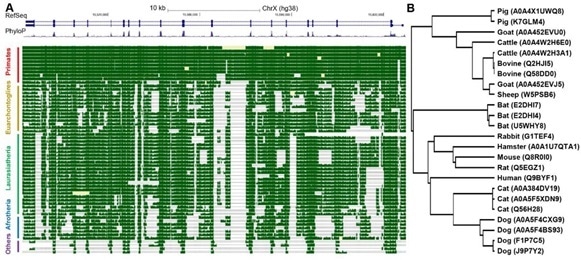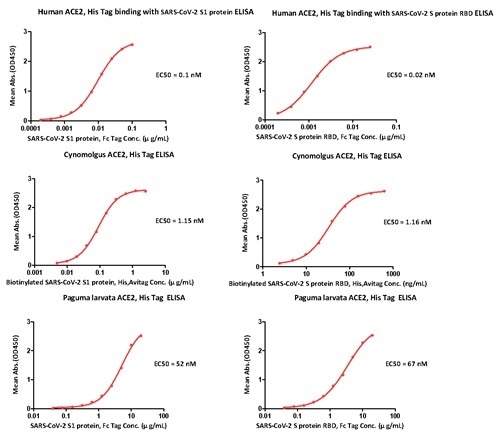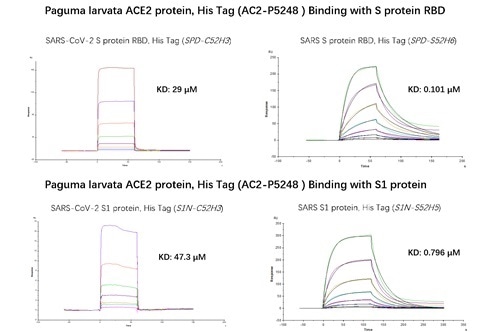The spike protein covering the surface of the virus SARS-CoV-2 allows viral entry into the target cell by exploiting the Angiotensin-converting enzyme 2 (ACE2) receptor. Due to the ACE2 gene being stored in high-concentrations in mammalian animals at the DNA and peptide level, they are likely potential hosts for SARS-CoV-2.
A recent study revealed that the ACE2 gene was detected in 12 common mammal species. They include humans as the primary host of SARS-CoV-2; bats and pangolins are presumed to be the intermediate host; mice, typically used as animal models in laboratory and experimental conditions; dogs, cats, hamsters, and ferrets which are common pets; and cattle, pigs, rabbits, and goats which are common livestock.1 Besides these 12 mammals, paguma larvata, an important host of SARS, also has ACE2 expression2.
Although expressed in mice, ACE2 is not in present any type of lung cells, only in the tongue and skin. Thus, it is implied that the expression pattern of ACE2 protein in mammals can be species-specific. Amino acid residues reside on the binding surface of ACE2 which are crucial for virus recognition.
Mutations in these amino acid residues may steer the sensitivity change of infection across different species. Seven important differences were detected between the sequence of human ACE2 and mouse or rat ACE2. These disparities could be why mouse or rat ACE2 protein does not bind to SARS-CoV-2 RBD protein. Therefore, rodent models such as rats and mice may not be appropriate for SARS-CoV-2 studies.
A number of studies have revealed that the skin and cornea of dogs have high-expressions of the ACE2 gene. This may make dogs vulnerable to SARS-CoV-2. Furthermore, as illustrated in the ACE2 phylogenetic tree below (Fig. 1), dogs are nearer to humans than other mammals, signifying that as an animal model for COVID-19 study they may be better suited.1

Figure 1. Conservation analysis of ACE2 gene. Image Credit: Sun et al., 2020 Atlas of ACE2 gene expression in mammals reveals novel insights in transmission of SARS-Cov-2.
In addition to dogs, ape and monkey species are also vulnerable to SARS-CoV-2. Multiple infection studies have revealed that rhesus monkeys could be successfully infected with SARS-CoV-2, and thereafter develop COVID-19 like symptoms. The Cynomolgus ACE2 (Cat. # AC2-C52H7) cultivated by ACRO has been confirmed to demonstrate excellent binding activity with SARS-CoV-2 S1 protein and S RBD protein, which also shows that cynomolgus ACE2 is very much homologous with Human ACE2.3
To summarize, dogs and monkeys are better animal models for SARS-CoV-2 and COVID-19 research.
Bioactivity-ELISA
Notably, Paguma larvata is a significant host of SARS as well as its ACE2 receptor protein demonstrating an excellent binding ability to the S protein of SARS-CoV-2. While not comparable to human and cynomolgus ACE2, we performed an ELISA assay to confirm the following results: as illustrated in Fig. 2 below, the EC50s of paguma larvata ACE2 to SARS-CoV-2 S1 protein and S RBD protein were 52 nM and 67 nM, respectively. Moreover, the EC50s of cynomolgus ACE2 to SARS-CoV-2 S1 protein and S RBD protein were 0.1 nM and 0.02 nM accordingly. By way of contrast, the EC50s of human ACE2 to SARS-CoV-2 S1 protein and S RBD protein were 1.15 nM and 1.16 nM, respectively.

Figure 2. ELISA Binding activity results.
Bioactivity-BLI
Using BLI, we examined the binding activity between the ACE2 of human, cynomolgus or paguma larvata, and the S RBD of SARS-CoV-2. The results are displayed in Fig.3. The binding activities of human and cynomolgus ACE2 to the S RBD of SARS-CoV2 are much greater than paguma larvata ACE2.

Figure 3. BLI binding activity results.
Bioactivity-SPR
In order to investigate the connection of binding between paguma larvata ACE2 and S RBD or S1 protein of SARS and SARS-CoV-2, an SPR method was carried out. Supported by the results in Fig.4, it was determined that paguma larvata ACE2 is more susceptible to SARS than SARS-CoV-2.

Figure 4. SPR binding activity results.
Table 1. Product list of ACE2 proteins.

About ACROBiosystems
ACROBiosystems is a cornerstone enterprise of the pharmaceutical and biotechnology industries. Their mission is to help overcome challenges with innovative tools and solutions from discovery to the clinic. They supply life science tools designed to be used in discovery research and scalable to the clinical phase and beyond. By consistently adapting to new regulatory challenges and guidelines, ACROBiosystems delivers solutions, whether it comes through recombinant proteins, antibodies, assay kits, GMP-grade reagents, or custom services. ACROBiosystems empower scientists and engineers dedicated towards innovation to simplify and accelerate the development of new, better, and more affordable medicine.
Sponsored Content Policy: News-Medical.net publishes articles and related content that may be derived from sources where we have existing commercial relationships, provided such content adds value to the core editorial ethos of News-Medical.Net which is to educate and inform site visitors interested in medical research, science, medical devices and treatments.